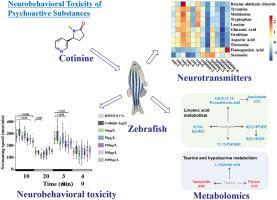当前位置:
X-MOL 学术
›
Environ. Pollut.
›
论文详情
Our official English website, www.x-mol.net, welcomes your feedback! (Note: you will need to create a separate account there.)
Environmentally relevant exposure to cotinine induces neurobehavioral toxicity in zebrafish (Danio rerio): A study using neurobehavioral and metabolomic approaches
Environmental Pollution ( IF 8.9 ) Pub Date : 2024-03-19 , DOI: 10.1016/j.envpol.2024.123826 Dan Yang , Wenfei Yu , Jiajia Qu , Yuexing Shen , Jingtong Yu , Ruirui Meng , Zhen Tao , Jiangfei Chen , Wei Du , Haitong Zhe Sun , Yunhui Zhang , Yuanchen Chen , Meirong Zhao
Environmental Pollution ( IF 8.9 ) Pub Date : 2024-03-19 , DOI: 10.1016/j.envpol.2024.123826 Dan Yang , Wenfei Yu , Jiajia Qu , Yuexing Shen , Jingtong Yu , Ruirui Meng , Zhen Tao , Jiangfei Chen , Wei Du , Haitong Zhe Sun , Yunhui Zhang , Yuanchen Chen , Meirong Zhao

|
As an important psychoactive substance, cotinine is ubiquitous in aquatic environment and poses a threat to aquatic organisms. However, the mechanism of its adverse health impacts remains unclear. We evaluated the effects of cotinine exposure at environmentally relevant concentrations on the development and locomotor behavior of zebrafish () larvae using neurotransmitters and whole endogenous metabolism. Mild developmental toxicity and significant neurobehavior disorder, such as spontaneous movement (1–1000 μg/L), 48 hpf tactile response (50, 100, and 1000 μg/L), and 144 hpf swimming speed (1, 10, 100, 500, and 1000 μg/L), were observed in zebrafish. Exposure to cotinine led to significant alterations in 11 neurotransmitters, including homogentisic acid, serotonin, glutamic acid and aspartic acid, etc. 298 metabolites were identified and two pathways - linoleic acid metabolism and taurine and hypotaurine metabolism - were delineated. In addition, amino acid neurotransmitters were significantly correlated with metabolites such as arachidonic acid as well as its derivatives, steroidal compounds, and amino acids. Serotonin demonstrates a noteworthy correlation with 31 out of 40 differentially expressed neurotransmitters, encompassing lipids, amino acids, and other compounds. These novel findings contribute to a comprehensive understanding of the ecological risks associated with cotinine contamination in surface waters.
中文翻译:

与环境相关的可替宁暴露会引起斑马鱼(Danio rerio)的神经行为毒性:一项使用神经行为和代谢组学方法的研究
可替宁作为一种重要的精神活性物质,在水生环境中普遍存在,对水生生物构成威胁。然而,其对健康产生不利影响的机制仍不清楚。我们使用神经递质和整个内源代谢评估了环境相关浓度的可替宁暴露对斑马鱼幼虫发育和运动行为的影响。轻度发育毒性和显着的神经行为障碍,例如自发运动(1–1000 μg/L)、48 hpf触觉反应(50、100和1000 μg/L)和144 hpf游泳速度(1、10、100、500)和 1000 μg/L),在斑马鱼中观察到。接触可替宁导致11种神经递质发生显着改变,包括尿黑酸、血清素、谷氨酸和天冬氨酸等。鉴定出298种代谢物,并描绘了两条途径——亚油酸代谢和牛磺酸和亚牛磺酸代谢。此外,氨基酸神经递质与花生四烯酸及其衍生物、甾体化合物和氨基酸等代谢物显着相关。血清素与 40 种差异表达的神经递质中的 31 种存在显着的相关性,包括脂质、氨基酸和其他化合物。这些新发现有助于全面了解与地表水中可替宁污染相关的生态风险。
更新日期:2024-03-19
中文翻译:

与环境相关的可替宁暴露会引起斑马鱼(Danio rerio)的神经行为毒性:一项使用神经行为和代谢组学方法的研究
可替宁作为一种重要的精神活性物质,在水生环境中普遍存在,对水生生物构成威胁。然而,其对健康产生不利影响的机制仍不清楚。我们使用神经递质和整个内源代谢评估了环境相关浓度的可替宁暴露对斑马鱼幼虫发育和运动行为的影响。轻度发育毒性和显着的神经行为障碍,例如自发运动(1–1000 μg/L)、48 hpf触觉反应(50、100和1000 μg/L)和144 hpf游泳速度(1、10、100、500)和 1000 μg/L),在斑马鱼中观察到。接触可替宁导致11种神经递质发生显着改变,包括尿黑酸、血清素、谷氨酸和天冬氨酸等。鉴定出298种代谢物,并描绘了两条途径——亚油酸代谢和牛磺酸和亚牛磺酸代谢。此外,氨基酸神经递质与花生四烯酸及其衍生物、甾体化合物和氨基酸等代谢物显着相关。血清素与 40 种差异表达的神经递质中的 31 种存在显着的相关性,包括脂质、氨基酸和其他化合物。这些新发现有助于全面了解与地表水中可替宁污染相关的生态风险。



























 京公网安备 11010802027423号
京公网安备 11010802027423号